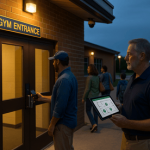
Renovations, annex builds, and temporary relocations create a perfect storm for risk. Doors are propped open. Contractors rotate daily. Cameras get taken offline while ceilings are open. If you manage municipal facilities, you need a plan that keeps people and property safe while work is underway and services continue.
This guide explains how to secure construction and renovation sites for public buildings with practical steps you can put in place now. We will focus on three pillars of protection that map to your core goals: secure access control for city buildings, public building surveillance, and government facility security systems that scale as the project evolves.
l
l
1) Start with a short, focused risk assessment
Before the first demo day, walk the site and document:
-
Which doors will change function during construction
-
Which cameras and alarms will be removed or relocated
-
Which spaces will host temporary staff or public services
-
Where materials, tools, and IT gear will be staged
-
How emergency egress and ADA routes will be maintained
Deliver a one-page matrix that lists each risk, owner, mitigation, and target date. This becomes the baseline you update at every construction meeting.
l
l
2) Control who gets in, where, and when
Contractor and vendor access is the most common gap during projects. Replace unmanaged keys and shared PINs with time-bound, auditable credentials.
Good practices
-
Issue mobile or QR credentials that auto-expire daily or weekly
-
Create contractor access zones that exclude administrative or records areas
-
Require escort rules for sensitive spaces such as IT closets and evidence storage
-
Capture government ID at enrollment and keep a sign-in photo for verification
-
Reconcile the active contractor list every week with the general contractor
Outcome: Only the right people reach the right work areas, and you can prove it.
l
l
3) Keep eyes on the site with temporary surveillance
When ceilings open and cameras come down, visibility disappears. Maintain coverage with portable, NDAA-compliant solutions.
Options to consider
-
Rapid-deploy camera kits with cellular backhaul and battery backup
-
Pole-mount units for lots, laydown yards, and staging areas
-
Indoor mini-domes on magnetic or clamp mounts during ceiling work
-
Analytics for loitering, line-crossing, and after-hours motion alerts
-
Shared viewing links for facilities, project managers, and law enforcement
Outcome: Public building surveillance continues without gaps, and incident video remains easy to find and share.
l
l
4) Protect the perimeter and the pathways
Construction fencing, dumpsters, and stored materials redraw the map of your site. That adds blind spots and new temptations.
Checklist
-
Light the perimeter and all temporary footpaths from dusk to dawn
-
Place cameras to watch gates, tool cribs, fuel storage, and loading zones
-
Use door-position sensors on temporary doors and trailers
-
Add clear wayfinding and “authorized personnel only” signage to reduce accidental trespass
-
Logistics map: show delivery routes, staging locations, and access points for first responders
l
l
5) Safeguard data and building systems
Renovation phases often expose cabling, switches, and panels. This is where physical and cyber risk converge.
Controls
-
Lock IT closets and electrical rooms with role-based access and audit logs
-
Store switches and NVRs in secured enclosures during ceiling work
-
Segregate contractor Wi-Fi and prevent device bridging onto city networks
-
Track movement of any servers, recorders, or workstations during temporary relocations
l
l
6) Plan for operations during temporary moves
If you are relocating services to trailers or swing space, treat these as official extensions of the building.
-
Install access readers on trailer doors with schedules tied to business hours
-
Use compact intercoms at public entries for service windows and payment counters
-
Place cameras to cover entrances, queues, ADA ramps, and cash handling
-
Maintain panic buttons or mobile duress for front-line staff
l
l
7) Document everything for compliance and insurance
Projects bring auditors and adjusters. Keep records that show due diligence.
-
Site security plan with dated revisions
-
Credential roster and weekly removals
-
Camera uptime reports and incident exports
-
Proof of NDAA-compliant hardware and OSDP-based reader wiring
-
Daily checkpoint log for fence lines, gates, and emergency routes
k
k
8) Phase your security like you phase construction
Security should move in step with the schedule. Use a simple three-phase model:
Phase A: Pre-construction
-
Baseline risk assessment
-
Contractor onboarding workflow
-
Temporary camera and lighting plan
-
Emergency egress and ADA review
Phase B: Active construction
-
Weekly credential reconciliation
-
Camera redeployments as ceilings open and close
-
After-hours alerting to facilities or dispatch
-
Incident reviews and mid-course corrections
Phase C: Closeout and handoff
-
Final credential purge for contractors
-
Commissioning test of permanent cameras, alarms, and readers
-
Updated as-built security drawings and device inventory
-
Post-project lessons learned
k
k
Common pitfalls to avoid
-
Shared PINs or universal keys that outlive the project
-
Unlit laydown yards that invite theft of copper, fuel, and tools
-
Unsecured IT closets while ceilings are open
-
Camera gaps during demolition and cabling changeovers
-
No audit trail to prove who had access when something went missing
k
k
The payoff
A disciplined approach to access, surveillance, and documentation keeps projects on schedule, reduces theft and rework, and protects staff and citizens throughout the disruption. Most important, it preserves public trust by keeping services safe and available while the building improves.
Ready to secure your renovation or relocation
See how SSP helps government agencies protect their people and infrastructure during construction and swing-space operations.
Contact us for a fast site assessment and a phased security plan tailored to your schedule.


